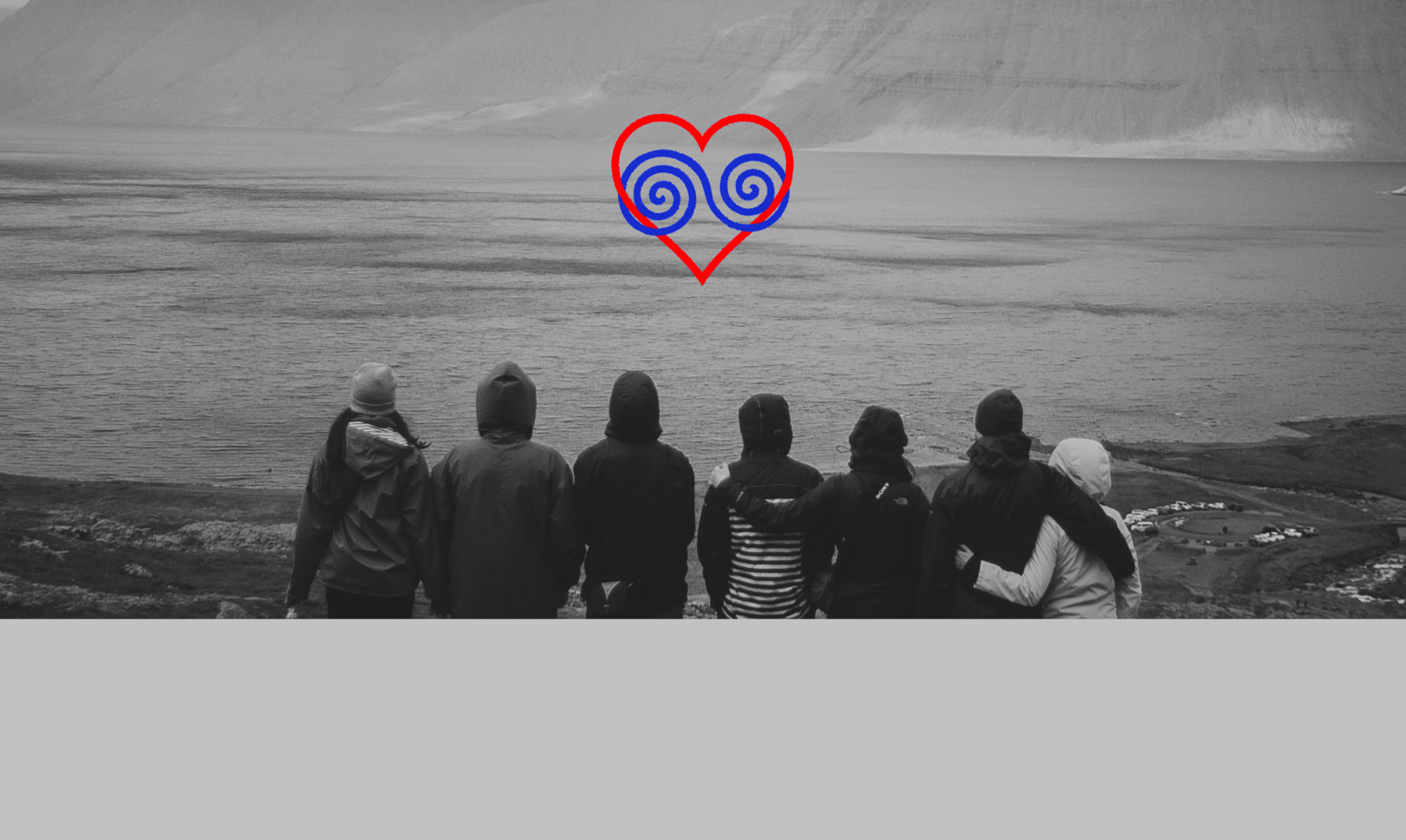From the ice they are freed, the stream and brook…

“One, two, three at whizzing pace time hurries – we hurry along.” This is what the German author Wilhelm Busch once wrote – and, hard to believe but true, the Oligoamory-bLog is now four years old!
For me, as the father of the birthday child, a proudly fulfilling opportunity to write once again about one of the more twisted paths through the landscapes of ethical multiple relationships.
Indeed, one of these narrow paths, which almost everyone involved has to follow regularly, leads through a treacherous frosty valley, which I would virtually describe as a “dichotomy”, between the balancing of personal freedom on the one hand and our longing for reliable attachment on the other.
At first glance, multiple relationship models often seem so attractive because they seem to promise us that we as participants can achieve more of the former (i.e., personal freedom) while at the same time increasing the latter (our desire for [more] attachment) – in any case at least more than could be achieved in (only) one monogamous relationship.
Very many people whom I have met and who are involved with ideas or even the implementation of multiple relationships quite regularly are already in touch with – hm…, let’s call it: “alternative potential” somewhere else in their lives.
It doesn’t have to be anything huge. But often these are minor to slightly major decisions contrary to something that is customary or predominant in the prevailing mainstream society. And this can be anything: The wraparound baby carrier, the purchase of organic food, involvement in a charitable organization or a political body, alternative spirituality, identification with a subculture (participation in special festivals of various music genres, medieval markets or even BDSM parties), participation in shared living arrangements or barter exchange, all the way to the creation of current art and culture. In many cases, therefore, those people here have already “thought themselves free” in certain areas of their lives from a “that’s the way everyone does it”.
Basically, I regard this as an extremely encouraging development, which for me also fits in with the history of multiple relationships in the 20th century, as I have presented it, for example, in my four-part historical review [Parts 1 | 2 | 3 | 4].
However, it was only during the lifetime of our own parents (or if you belong to Generation Y, Z or Alpha: our grandparents) that many patriarchal institutions began to dissolve [e.g. in Germany the medical profession only eased its restrictive attitude towards the “pill” as late as the end of the 1970s, which finally became a milestone for the reproductive self-determination of women also in my country; and it was not until 1977 (!) that actually the “First Law on the Reform of Marriage and Family” came into effect, according to which there was no longer a legally prescribed division of tasks in marriage – and women were now allowed to take up gainful employment even without her husband’s permission].
Thus, the striving for (more) freedom, especially after experiencing such long-term established authoritarian structures, has partly led to an effect of occasional overshooting, which I sometimes regard somewhat anxiously – because: “accustomed” to act in freedom, none of us, women, men or diverse, is, strictly speaking, yet.
What I mean by this is that under certain circumstances in our relationships we occasionally use “freedom” as a kind of “defensive right” against any perceived paternalism, against any supposedly unjustified liability – but therefore, unfortunately, sometimes also too lightly against some real responsibilities.
This is actually not surprising at all. Because as far as our love is concerned, there we want to be “completely ourselves”, there we feel that this is a decisive part of what I so often call here on the bLog our “core self”.
Which leads us to the other side of the treacherous valley, the dichotomy – our longing for reliable attachment. For in our core self we wouldn’t need love if we as “social animals” didn’t also carry this relatedness, this orientation towards other human beings.
By the way, I chose the phrase “longing for attachment” with some deliberation, because I believe that in this longing we assess ourselves in a rather idealized way on the one hand, and on the other hand, as Wikipedia says, we are at the same time occasionally identified with the anxious feeling of “no hope of attaining what is desired, or when attainment is uncertain, still distant”.
Which “when the occasion arises” means that our longing for attachment can quite quickly launch us into dramatic action not unlike – to choose an image – a person breaking through the ice on a frozen stretch of water.
How and why do we get on the ice at all? Usually it is our idealism: Surely we can handle that! We probably will be able to cross a solidly frozen lake. Nothing will happen to us, since we are experts on weather, ice conditions and especially on this lake!
Transferred to the relationship level, I would like to express herewith that we mostly go off with an idealized image of ourselves. A self-description in which we might say, “I see myself as a person who will act with commitment and loyalty (even in multiple relationships!). For this purpose, I have a set of guiding principles in me which are important to me and within which I will therefore act.”
So little can go wrong, we think – and off we go out onto the lake.
Sometimes, at that very moment, we have already abandoned our self-image both in terms of our commitment and our points of reference. In Entry 9, I wrote about the “Emotional Contract” that lies behind every more intimate interpersonal relationship. And either this “contract” allows a relationship to be considered “open” (for further connections) by all parties involved in it – or we have omitted to assure ourselves of this mutual equal evaluation, because, yes, because our personal freedom was just more important to us. Or rather, because at this moment we have given our personal freedom a higher priority than the commitment to already existing loved ones.
Whereby, in this case, a deep, ominous crack will immediately form on the lake as soon as we merely set foot on it. Because no matter what happens from there, ethically – in the sense of transparency, of equality or equal worthiness – things will no longer continue from here.
Our longing for more attachment has made us believe that we surely would be able to cross this lake – but the priority of our personal freedom has thereby caused all of our own safety valves (which I called guiding principles above) to burst; yes, of course, we still can enter the lake now – but on the course we have now taken, we will no longer be committed or loyal, we have dropped this part of our self-image, which we had actually claimed for ourselves, in the process.
Sure, it depends a bit on our personal resilience and ego (that is, on our callousness, dialectally speaking) – but such a shedding of a part of what we had until recently claimed as part of our identity will hardly pass anyone by without leaving a trace in the medium term. The consequences can range from pinching conscience or potential hangover to genuine remorse and massive shame (especially in front of ourselves), especially in the likely event that we don’t make it across the lake (meaning: that the continued/additional relationship doesn’t work out [as well/though]).
I let myself now already a little carried away in my descriptions regarding the circumstance that even the opening of a relationship is not clearly agreed upon.
What about the lake, however, if that is so – that it is agreed?
Well, then, accordingly, with the self-image “I see myself as a person who will act committedly and loyally with regard to all its existing and future engagements”, we set out on the lake, that is, into another relationship.
Gee! The POSSIBILITIES we now have on this lake!
This dizzying perspective, the oxygen shock, the unimagined momentum that this new experience offers…
Ice looks too cool on the surface, smooth, tempting and shiny – and very easily we forget that there is danger underneath…
For it happens very quickly that exactly at this moment, when our personal aspiration for freedom is rising to our heads, our longing for (more) attachment – which we had just valiantly affirmed and even safeguarded by our alternative relationship model – self-sabotages us.
On top of that, a phenomenon appears which is known and sometimes feared especially in multiple relationship circles as “NRE” (“New Relationship Energy”). Wikipedia substantiates: “…a state of mind experienced at the beginning of sexual and romantic relationships, typically involving heightened emotional and sexual feelings and excitement. NRE begins with the earliest attractions, may grow into full force when mutuality is established, and can fade over months or years.”
“New relationship energy” can therefore in principle also mean something good for the added relationship – but unfortunately it is sometimes already the indicator of breaking ice.
So what exactly brought us out onto the lake?
If our “longing for (more) attachment” contains a component of increased neediness (and, because we are not yet “habitual users of freedom,” this is not at all unlikely), then there is a danger that we will blow our safety valves the moment the sheer possibility of another intimate/romantic relationship becomes apparent to us, as in my first example. Due to the (im)balance of our inner needs we “want” so urgently another relationship that we are inclined to drop blindly – and additionally disinhibited by plenty of NRE-hormones – a part of our self-image, which is usually claimed by us, just for the sake of somehow ensuring the new emerging relationship.
The ice breaks.
Something happens that many cohabiting partners in multiple relationships, even in “ethical” ones like Polyamory, experience too regularly: The beloved person not only seems to suddenly turn over predominant parts of emotions, time and substantial resources to the new relationship person, no – objections, concerns, suggestions concerning existing liabilities and obligations are easily dismissed, relativized, perhaps ridiculed or even condemned as “unjustified” with the (expressed or also implicit) reference to personal freedom – even by pointing out possessive behaviour, monoamorous pettiness and a lack of compersion.
It is absolutely understandable that existing partners at this point literally “do not recognize” their favourite person who has just broken into the ice: because until a short time ago the favourite person acknowledged (and behaved according to) values and ideals of his or her “core self” which now suddenly can hardly be observed.
If we are the person who has broken into the ice in this way, then it will be difficult to “save” ourselves. Since we have just lost the ground under our feet that we thought to be safe a minute ago, we start to realize that we “flounder”…
We want to keep the new relationship, which is not yet really established, at all costs, not to leave the already existing one(s), because until now they have offered us the support of a solid shore – and so we smash more and more of the ice around us in the name of personal freedom (because we impetuously try to remain master/mistress of the gradually dissolving situation), so that both the danger exists that we really sink – and the risk grows that we are no longer reachable from the outside and destroy the last of the “substance” that once connected us to firm ground.
Very regularly, in poly- and oligoamorous communities, personal freedom and the unconditional “openness” of love are still given a very high value, in a way that one would probably attribute to the highest and all other cards beating trump in a poker game. Among other things, in my Entry 28 (Freedom of Love) and Entry 67 (Open Love) I describe why this approach, in my view, does not help to establish trusting and appreciative (multiple) relationships based on eye level equality.
Breakaway personal freedom in intimate human relationships is like a sharp shrapnel, with the potential to do much damage, even to the point of destroying the concerned relationships. In Entry 42 I argue that in our closest relationships our personal striving for freedom must therefore be embedded in the personal assumption of responsibility.
For our established partners, such ” self-effacement events” (when we strip ourselves of actually important parts of ourselves in a feverish effort to establish another relationship) are, as described above, frightening and often hurtful processes.
We, as fallible – and occasionally needy – human beings, can probably never completely prevent such things from happening.
What we can do, however, is to find our way back to our core self – to what is important to us and what should characterise us – on our own accord, to take up responsibility for our actions, and thus, for the people who know us and not least for our own sense of identity.
Our longing for attachment – as unfulfilled or already fulfilled as it is at this very moment – will repay us. Because at the end of the day, what matters in our hearts is not what parts of ourselves we have sacrificed in the struggle for personal freedom; that keeps us neither warm nor satisfied.
At the end of the day, we want to return to our loved ones, want to rejoice in their recognition of us.
And we want to have quite undivided joy in ourselves when we look in the mirror, that we may be idealistic, a little crazy and certainly are provided with a few not always quite predictable idiosyncrasies.
But that after all we can still recognize a reassuring correlation of meaning, a real sovereignty – conferring conclusiveness between our ideal self, which we would like to be, and our actually perceived self, which we are right here and now.¹
Both affirming and comforting.
…or as Johann Wolfgang von Goethe described it at the end of his “Easter Walk” (part of “Faust“), of which the first line already served me as the heading of this Entry:
»Contented, great and small shout joyfully:
Here I am human, here dare it to be!«
¹ This last line refers to the important psychological concept of “Coherence” described by Carl Rogers
Thanks to Vincent Foret on Unsplash for the picture!

